
Have you ever wondered about the fascinating journey an emu takes from a fragile egg to a majestic adult?
Step into the world of these remarkable birds as we explore the intricate lifecycle that shapes their existence.
From the delicate process of incubation to the challenges of adolescence and the triumphs of adulthood, the emu's journey is a captivating tale of survival and growth.
So, get ready to embark on a captivating journey as we unravel the secrets of the emu's lifecycle, revealing the wonders that await at every stage.
Emu Eggs: The Beginning of Life
Emu eggs, the starting point of an emu's life cycle, are laid by female emus and play a crucial role in the reproduction of this unique and fascinating species. These eggs are relatively large, weighing around 500 to 700 grams, and have a dark green color that blends seamlessly with their surroundings.
The incubation period for emu eggs lasts approximately 52 days, during which the male emu takes on the responsibility of caring for the eggs. This is a rare occurrence in the avian world, as it's usually the female's role to incubate the eggs. However, male emus possess a specialized pouch on their bellies that provides them with the necessary heat for successful incubation.
Incubating emu eggs isn't without its challenges. One of the main obstacles is maintaining the ideal temperature and humidity levels. Emu eggs require a constant temperature of around 97 degrees Fahrenheit (36 degrees Celsius) and a humidity level of 50 to 55 percent. Any deviations from these conditions can significantly impact the development of the embryo. Additionally, the risk of bacterial contamination during incubation is high, which can lead to the failure of hatching. Therefore, it's essential to ensure proper sanitation and hygiene throughout the incubation process.
Despite these challenges, emu eggs have a remarkable ability to withstand adverse conditions. Their thick, sturdy shells provide excellent protection against predators and environmental factors. The hatchlings emerge from the eggs fully developed and ready to face the world.
Emu egg incubation and hatching are critical stages in the life cycle of these fascinating creatures, marking the beginning of their journey towards adulthood.
Incubation Period: A Delicate Process
After successfully laying their eggs, female emus entrust the delicate process of incubation to the male emu, who plays a crucial role in ensuring the ideal temperature, humidity, and sanitation conditions necessary for the development and hatching of the emu embryos. The incubation period is a critical stage in the lifecycle of an emu, where the embryos undergo significant growth and transformation. Understanding the importance of temperature control during incubation is essential, as the embryos are highly sensitive to fluctuations.
Challenges faced during the incubation period include maintaining a constant temperature, typically around 97-99 degrees Fahrenheit, as any deviation can negatively impact embryo development. Additionally, the humidity levels need to be carefully regulated, usually between 25-45%, to prevent dehydration or excessive moisture. Lastly, ensuring proper sanitation is crucial to prevent the growth of harmful bacteria that could harm the developing emu embryos.
During this delicate process, the male emu diligently maintains the nest, rotating the eggs regularly to ensure uniform heat distribution. He also guards the nest against predators and adjusts his posture to regulate the temperature. The male emu's commitment and attention to detail greatly contribute to the successful hatching of the emu chicks.
Hatching: Breaking Free From the Shell
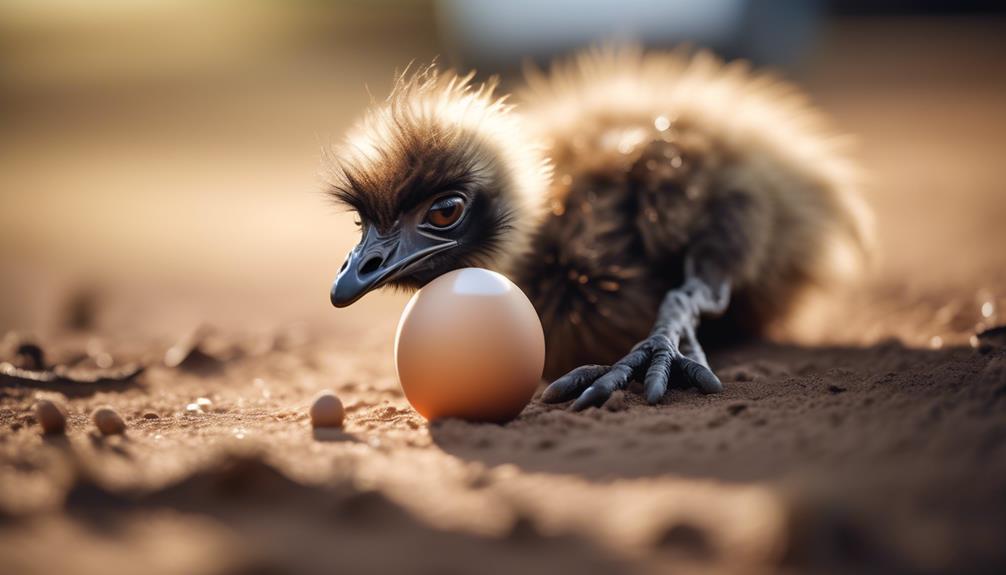
Once the incubation period is complete, the emu embryos begin the remarkable process of breaking free from their shells. This stage, known as hatching, marks the transition from a protected, internal environment to the outside world. The emu chicks use their developing muscles and beaks to crack open the shell, creating a small hole called a "pip." Through this pip, they will take their first breaths of air.
As the emu chick continues to push and wiggle, the pip gradually expands. The process can take several hours and requires immense effort. The tiny chick must use its strength to break through the shell, a protective barrier that has nurtured its growth for weeks. It is a moment of struggle and determination, as the chick fights to escape the confines of its enclosure.
To convey the emotional impact of this process, here is a table highlighting the stages of shell development leading up to hatching:
| Stage of Shell Development | Description |
|---|---|
| Formation of Shell | The emu eggshell is formed within the mother's reproductive system. It consists of calcium carbonate and protein layers, providing protection and support for the developing embryo. |
| Shell Hardening | As the embryo grows, the shell hardens, becoming more resilient and protective. This process ensures that the chick has a sturdy structure to break free from during hatching. |
| Pipping | The emu chick begins the hatching process by creating a small hole, known as a pip, in the shell. This allows for the exchange of gases and marks the start of the chick's efforts to break free. |
| Breaking Free | Through continued pushing and wiggling, the emu chick expands the pip, eventually breaking free from the shell. This process requires strength and determination. |
| Emergence | Once free from the shell, the emu chick emerges into the world, ready to embark on its journey of growth and survival. |
As the emu chick breaks free from its shell, it symbolizes a triumph of life over confinement. This momentous event sets the stage for the chick's next phase of development, as it enters the world and begins its transformation into a full-grown emu.
Early Life: Emu Chicks and Their Parents
During the early life of emu chicks, their parents play a vital role in providing care and guidance for their offspring. Emu parenting is characterized by several interesting behaviors that ensure the survival and development of the chicks.
- Nesting: Emus build nests on the ground using materials such as leaves, grass, and feathers. The male emu takes charge of constructing the nest, while the female lays the eggs. This division of labor allows the male to closely guard the eggs and protect them from predators.
- Incubation: After the female lays her eggs, the male takes on the responsibility of incubating them. He carefully turns the eggs and maintains the optimal temperature and humidity levels required for successful hatching. This dedication ensures the embryos develop properly.
- Feeding: Once the chicks hatch, both parents actively engage in feeding them. Emu chicks are born with a strong instinct to peck at objects, which helps them identify food. The parents guide them to suitable food sources and provide them with a balanced diet to support their growth.
Emu parenting involves a remarkable level of dedication and cooperation between the male and female. Through their nurturing behaviors, emu parents ensure the survival and well-being of their chicks during the crucial early stages of life.
Feeding and Growth: Nurturing the Young Emus
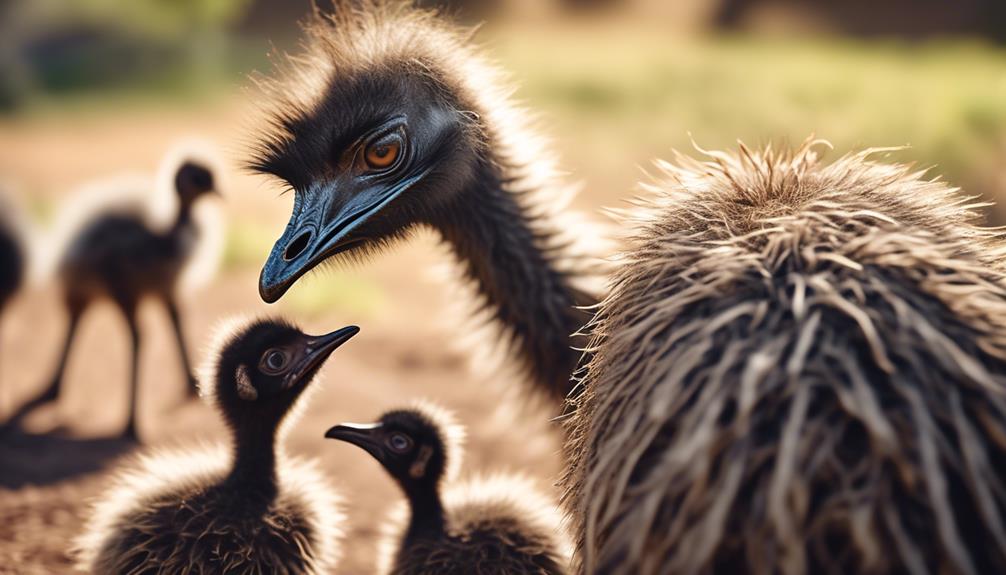
Emu parents play a crucial role in nurturing the young emus through their feeding and growth stages, ensuring their survival and development. Emu parenting involves meeting the nutritional needs of the chicks, which is essential for their healthy growth. From the moment they hatch, the chicks depend on their parents for nourishment and guidance.
During the early stages of their lives, young emus rely on their parents for a steady supply of food. The parents diligently search for insects, fruits, and seeds to provide the necessary nutrients for their chicks. They use their sharp beaks to pick up food items and then regurgitate them for the chicks to eat. This feeding process not only fulfills their nutritional needs but also strengthens the bond between the parents and their offspring.
As the chicks grow, their nutritional needs evolve. Emu parents adapt their feeding habits accordingly, gradually introducing them to a wider variety of food sources. They teach the young emus how to forage for themselves, allowing them to develop the necessary skills to survive in the wild. As the chicks become more independent, they continue to learn from their parents and gradually explore their environment.
Emu parenting involves not only providing nourishment but also fostering the growth and development of the young emus. The parents' guidance and support ensure that the chicks receive the necessary nutrients to thrive and reach adulthood successfully. Their attentive care plays a vital role in the overall wellbeing and survival of the young emus.
Socialization: Building Connections With the Flock
After ensuring the nourishment and growth of their young, emu parents play a crucial role in building connections with the flock through socialization. This process is essential for the development of the young emus and the overall cohesion of the flock.
Here are three key aspects of socialization in emus:
- Vocal Communication: Emus use a variety of vocalizations to interact with each other. From soft purrs to loud booming calls, these vocalizations serve as a means of establishing and maintaining social bonds within the flock. Through vocal communication, emus can convey their intentions, emotions, and even warnings to other members of the flock.
- Body Language: Emus also rely on body language to convey messages and establish social hierarchies within the flock. They engage in various displays, such as head bobbing, wing spreading, and feather ruffling, to communicate dominance, submission, and territorial boundaries. This non-verbal communication is crucial for maintaining order and minimizing conflicts within the flock.
- Social Interactions: Emus engage in a range of social behaviors, including grooming, preening, and playing, to strengthen their relationships with other flock members. These interactions help build trust, cooperation, and a sense of belonging. Through shared activities, emus create a unified social structure that benefits the entire flock.
Understanding the intricacies of building relationships and flock dynamics in emus allows us to appreciate the complex social lives of these fascinating creatures. Through socialization, emus establish bonds that contribute to the overall stability and well-being of their flock.
The Juvenile Stage: Emus on the Path to Adulthood
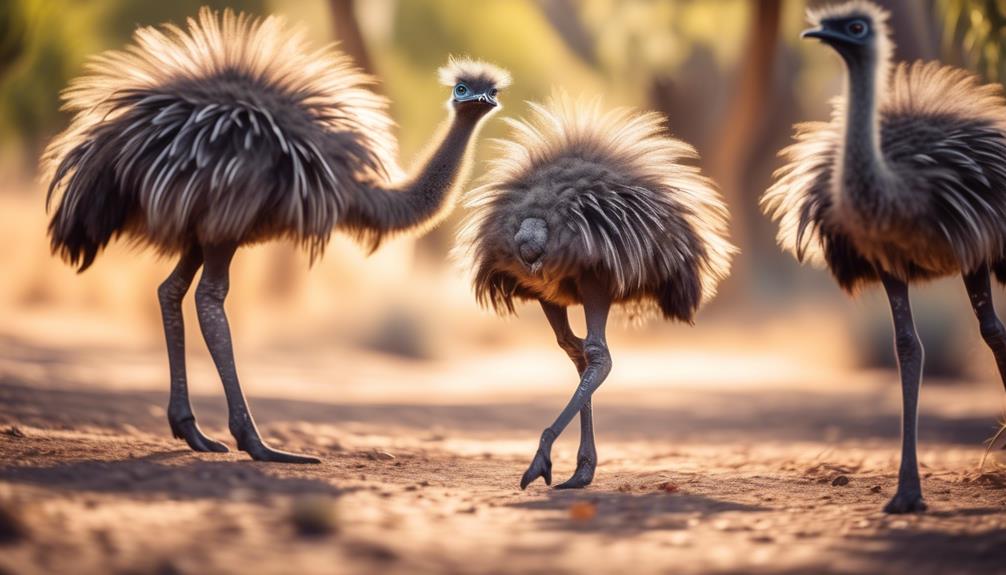
As juveniles, emus undergo a series of physiological and behavioral changes that mark their transition towards adulthood. During this stage, emu behavior becomes increasingly independent as they explore their surroundings and learn important survival skills. Juvenile emus receive care from their parents or the adult members of their flock, who play a crucial role in their development.
Emus in the juvenile stage exhibit a curious and exploratory nature. They spend much of their time foraging for food, which includes a variety of plant matter and insects. This behavior allows them to learn about different food sources and develop their hunting skills. They also engage in play, often running and jumping around in a display of energy and vitality.
Juvenile care is provided by adult emus within the flock. These adults act as mentors, guiding the young emus and teaching them important skills for survival. They demonstrate proper foraging techniques, alert the juveniles to potential dangers, and provide protection from predators. Through this guidance, the juveniles gradually learn to navigate their environment and become self-sufficient.
The juvenile stage is a critical period in the emus' development, as it prepares them for adulthood. The combination of independent behavior, exploratory nature, and guidance from adult emus ensures that they acquire the necessary skills and knowledge to thrive in their environment. As they continue to grow and mature, the juveniles will eventually transition into adulthood, ready to take on the challenges and responsibilities that come with it.
Mating Season: Emus and Reproduction
During the mating season, emus engage in a series of reproductive behaviors that are vital for the continuation of their species. These behaviors are driven by instinct and designed to maximize the chances of successful fertilization and egg development.
Here are three key mating behaviors observed in emus:
- Courtship displays: Male emus will perform elaborate courtship displays to attract the attention of females. These displays involve puffing up their feathers, extending their necks, and emitting deep booming sounds. The purpose of these displays is to demonstrate their strength and fitness to potential mates.
- Pair bonding: Once a male successfully attracts a female, they form a pair bond that lasts for the duration of the mating season. During this time, they engage in mutual preening and affectionate behaviors to strengthen their bond. This bond ensures that the male will be available to protect the female during nesting and incubation.
- Copulation: Emus have unique reproductive organs that allow for internal fertilization. The male's cloaca, a single opening that serves as the exit for waste and the entrance for reproductive organs, becomes engorged with blood during copulation. This allows the transfer of sperm to the female's reproductive tract for fertilization.
These mating behaviors, along with the intricate physiology of their reproductive organs, ensure the successful reproduction and survival of emu populations.
Nesting and Egg-laying: Continuing the Cycle
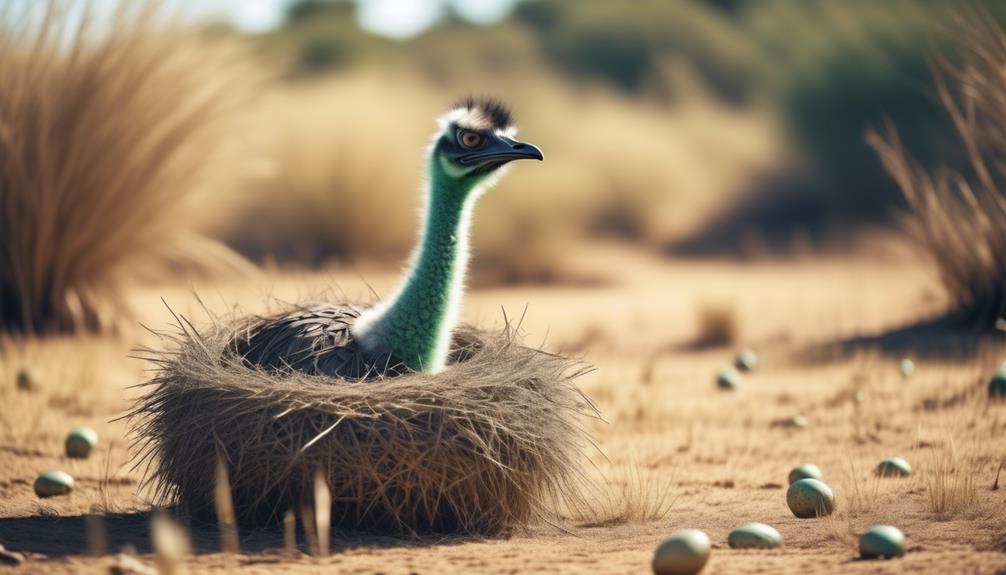
Nesting and egg-laying in emus is a crucial phase in their lifecycle, marking the continuation of the reproductive cycle. After successful mating, the female emu seeks out a suitable nesting site, which is usually a sheltered area with plenty of vegetation for camouflage and protection. She constructs a shallow nest by scraping a depression in the ground, using her powerful legs and feet. Once the nest is ready, the female emu begins the process of egg-laying.
Emu eggs are large and greenish-blue in color, and the female usually lays between 5 to 15 eggs over a period of several days. She then starts the process of incubating the eggs, which involves sitting on the nest and keeping the eggs warm for approximately 56 days. During this period, the male emu takes on the responsibility of guarding the nest and providing food for the female. This brooding behavior ensures the survival of the eggs and allows the female emu to conserve her energy for the upcoming period of incubation.
Nesting and egg-laying are critical steps in the emu's reproductive cycle, as they lead to the development of new individuals. These behaviors showcase the remarkable adaptability and nurturing instincts of emus, allowing them to successfully continue their lifecycle.
Emu Adolescence: Developing Strength and Skills
Emu adolescence is a critical period of development where young emus acquire the necessary strength and skills to navigate their environment. During this stage, emus undergo significant physical changes and behavioral adaptations to prepare for adulthood.
Here are three key aspects of emu adolescence:
- Developing agility: As young emus transition from their fluffy chick stage, their bodies undergo a rapid growth spurt. This growth allows their muscles to develop and strengthen, enabling them to move with increased speed and coordination. Young emus spend their time engaging in playful activities, such as running and jumping, which helps them develop their agility.
- Honing hunting skills: Emus are omnivorous creatures and their diet primarily consists of vegetation. However, during adolescence, they begin to develop their hunting skills. They learn how to chase and catch small insects, which provides them with additional sources of nutrition. This hunting behavior not only helps them acquire vital nutrients but also enhances their ability to survive in the wild.
- Socializing and establishing hierarchies: Emu adolescence is also a time where young emus start to interact more with their peers. They form groups and engage in playful interactions, which help them develop important social skills. These interactions also allow emus to establish hierarchies within their groups, which is crucial for maintaining order and cooperation.
During adolescence, emus undergo significant physical and behavioral changes as they acquire the strength and skills necessary to survive and thrive in their environment.
Emu Adulthood: A Life of Survival and Mating
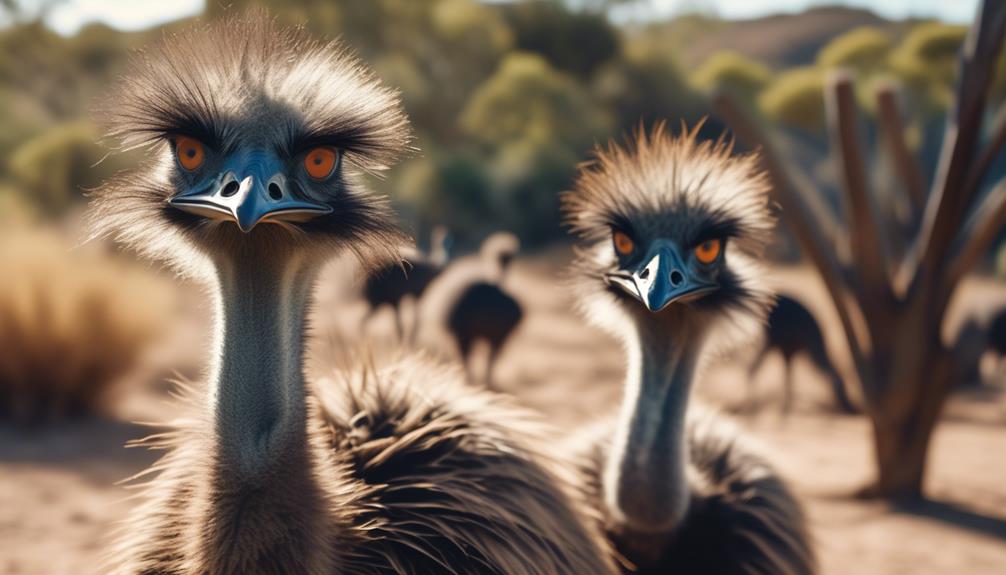
As young emus complete their adolescence, they enter into the stage of emu adulthood, where their focus shifts towards the challenges of survival and the pursuit of mating opportunities. In this phase of their lives, emus employ various survival techniques to navigate their environment and ensure their continued existence. These techniques include their remarkable speed, which allows them to outrun potential predators, as well as their ability to camouflage themselves in their surroundings, blending seamlessly with the vegetation to avoid detection.
Emu courtship rituals are intricate and fascinating. Males begin by emitting low-frequency booming calls, attracting potential mates from afar. They then perform elaborate dances, showcasing their strength and agility. These dances involve intricate footwork, wing spreading, and rhythmic movements, all aimed at impressing the females. The females carefully observe these displays, carefully selecting the most impressive male to mate with.
To engage the audience further, here is a table that outlines some of the survival techniques and courtship rituals of emus:
| Survival Techniques | Courtship Rituals |
|---|---|
| Remarkable speed | Booming calls |
| Camouflage | Elaborate dances |
Frequently Asked Questions
How Long Does It Take for an Emu Egg to Hatch?
It takes around 54-60 days for an emu egg to hatch. The emu egg incubation period can be influenced by factors such as temperature and humidity.
At What Age Do Emu Chicks Start Feeding on Their Own?
Emu chicks, those little fluff balls, start feeding on their own when they reach around 6-8 weeks old. At this age, they become self-sufficient and gradually wean off parental care, developing their unique feeding behaviors.
How Many Eggs Does a Female Emu Typically Lay in a Nesting Season?
Female emus typically lay around 5-15 eggs in a nesting season. It's fascinating to observe their reproductive cycle and how they provide for their young. Emus truly embody the wonders of nature.
What Kind of Skills Do Emus Develop During Their Adolescence?
During their adolescence, emus develop important skills for their adult lives. They learn to navigate social interactions, honing their communication and cooperation abilities. Additionally, they undergo physical strength development, preparing them for the challenges of adulthood.
How Long Do Emus Typically Live in the Wild?
In the wild, emus typically live for about 10-20 years. They roam vast territories, adapting to various habitats, and face natural predators. Their lifespan depends on factors such as food availability and the absence of human interference.
Conclusion
In conclusion, the lifecycle of an emu is a fascinating process that involves various stages of growth and development. From the moment an emu egg is laid to the point of adulthood, these remarkable creatures undergo significant changes.
For example, a case study showed that emu chicks raised in a nurturing environment exhibited stronger survival skills in adulthood compared to those raised in isolation. This highlights the importance of parental care and social interaction in shaping the future of these magnificent birds.




